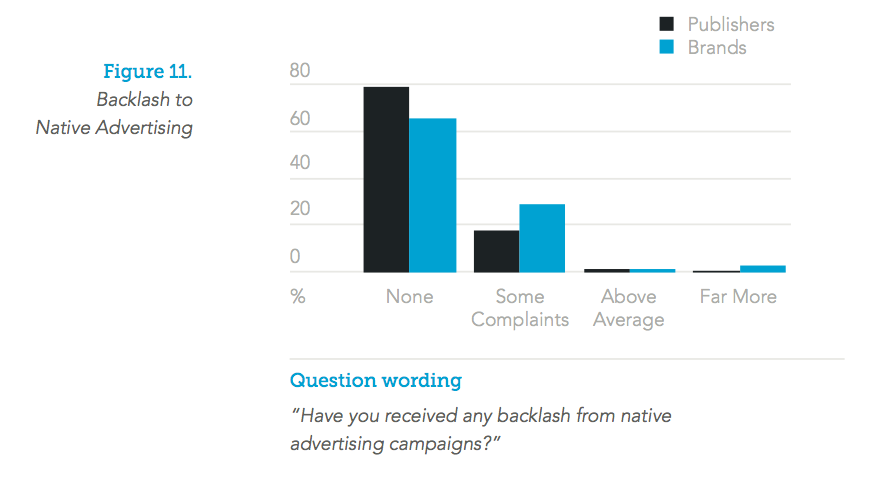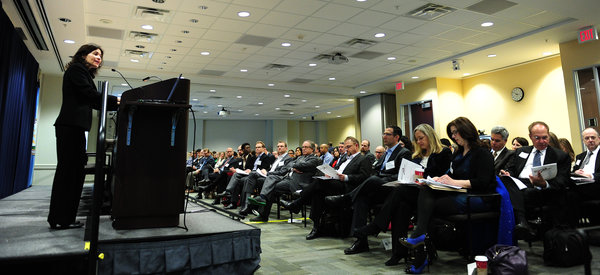Our 2013 ‘State of the Cuisinart Marketing’ Address
by John R. Carroll onDec 11, 2013 • 12:41 am 1 CommentRecipe for marketing in the 21st Century:
Ingredients
1 part news
1 part entertainment
1 part advertising
Directions
Combine in blender. Hit puree.
Serves: Everyone but the Jurassic types who think you have a right to know when you’re being advertised to.
Welcome to branded content, a.k.a. ads in sheep’s clothing.
It’s everywhere these days, from TV programs that let advertisers use characters from the show in commercial breaks, to cast members who deliver product pitches during the show, to advertisers paying their way into top trend lists, to the pioneering sponsored content in Mike Allen’s Politico Playbook daily tip sheet.
Regarding that last one:
A review of “Playbook” archives shows that the special interests that pay for slots in the newsletter get adoring coverage elsewhere in the playing field of “Playbook.” The pattern is a bit difficult to suss out if you glance at “Playbook” each day for a shot of news and gossip. When searching for references to advertisers in “Playbook,” however, it is unmistakable. And its practitioner is expanding the franchise.
Allen has added Capital Playbook, “a newsletter stemming from Capital New York, the news site that Politico acquired earlier this year,” to his growing roster of daily production. Presumably Politico Playbook’s branded content – and powderpuff coverage – will tag along with him.
But that’s to be expected, because publishers are on branded content like Brown on Williamson.
According to a new survey by Hexagram and Spada, 62% of publishers currently offer branded content/native advertising and another 16% plan to do so in the next year. Beyond that, MediaPost notes, “41% of brands and 34% of agencies currently use native advertising, with an additional 20% of brands and 12% of agencies planning to begin using it within the year.”
Part of the shell game resides in the multiple labels the marketers attach to native advertising, as illustrated in this graph:
Presumably, the more different labels you assign native advertising, the less prevalent it will seem to be. Staying under the radar is, after all, the name of the game.
But here’s the chart that worries the hardtracking staff the most:
No, wait – here’s the chart that worries us the most:
That could change in the near future, though, now that native advertising has captured the attention of the federal government. From the New York Times earlier this month:
As Online Ads Look More Like News Articles, F.T.C. Warns Against Deception
WASHINGTON — What happens when advertising stops being obvious?
The Federal Trade Commission, charged with protecting consumers and guarding against deceptive advertising practices, acknowledges it does not know.
But faced with a growing wave of digital advertising that is intended to look like the news articles and features of the publications where they appear, the commission is warning advertisers that it intends to vigorously enforce its rules against misleading advertising.
Concerned that “even information labeled advertising can mislead consumers,” FTC chairwoman Edith Ramirez warned the conference that “[by] presenting ads that resemble editorial content, an advertiser risks implying, deceptively, that the information comes from a nonbiased source.”
Well that’s the whole point, isn’t it?
Contrary to what the Hexagram and Spada survey found, FTC officials say “recent surveys on online publishers revealed that 73 percent offered native advertising opportunities on their sites and that an additional 17 percent were considering offering them this year.” (Hexagram and Spada said 62%/16%.)
Even worse, some web publishers are using their editorial staffs to create the marketing materials. According to the Times piece, “Mashable.com uses its reporters and editors to create the advertising content. The publication’s technology journalists are regularly used to create advertising ‘because it allows us to go more in depth’ in reporting, said Adam Ostrow, chief strategy officer for Mashable.”
That’s the dodge most web publishers use: We’re doing it for the benefit of our readers. They want a “seamless stream of content,” the publishers say, because traditional advertising is “too intrusive.”
Uh-huh.
So what’s the FTC to do?
Maybe nothing according to Reuters media critic Jack Shafer, who points out in this piece that the FTC itself could become the problem.
What’s worse than sponsored content? The FTC regulating it
What’s more dangerous to consumer well-being, sponsored content or the intervention of the Federal Trade Commission? On Wednesday, the agency held a conference, “Blurred Lines: Advertising or Content,” to “discuss native advertising,” as the New York Times put it. The event attracted several hundred “advertisers, academics and media executives,” who listened to the agency’s views about native advertising — or sponsored content, infomercial, or advertorial, as some call it — those Web ads that are designed to look like editorial content, not ads.
As Shafer notes, “[w]hen convening a conference to ‘discuss’ something or other, the FTC (or other regulatory entities) is almost never in pursuit of discussion.” Rather, it serves as a “[venue] in which the agency can issue a veiled threat, either directly or indirectly, to its targets, instructing them sotto voce that unless they change their ways they’ll suffer the agency’s wrath.”
The hardtracking staff has always believed that once you let the federal government into your house for whatever reason, well-meaning or not, it’s just a matter of time until the big lug kicks off his shoes and hunkers down on the sofa with a baloney sandwich. Shafer puts it a bit differently:
If the FTC seeks the power to decide what is an advertisement and what is editorial, I would have it seek that mandate from Congress and quit with its implied threats. Perhaps if the FTC leaves the Web alone, publishers and advertisers will eventually come to their senses about sponsored content, understanding that blurring their identities together damages both.
Because, he says, it makes publishers look like advertising stooges, and advertisers look “responsible for the site’s controversial editorial content.” So eventually both sides will see where their best interests lie.
The operative word for Shafer being perhaps. Well, the Lord loves an optimist, yeah?
So maybe it’s time for a pessimist.
Enter Wall Street Journal columnist Farhad Manjoo.
Why ‘Native Ads’ Muddy the Water for Web Surfers
I’m a writer who works in an industry that is supported primarily by advertising. So before I go on, I want to make one thing very clear: I love ads. Ads are terrific!
. . .
Yet, despite my love for ads, the time has come for me to very gently reprimand the advertising and Web-publishing industries for an increasingly common and increasingly confusing form of commercial sponsorship.
It’s called “native advertising,” an innocent name for ads that are often anything but.
The problem, Manjoo say, is just this: “The widespread adoption of native advertising is ushering in a Web where paid and unpaid messages increasingly blend together and where there are only the faintest visual distinctions between content that carries a commercial message and content that doesn’t.”
In other words, State of the Cuisinart Marketing.
Proceed at your own peril.
John R. Carroll is media analyst for NPR's Here & Now and senior news analyst for WBUR in Boston. He also writes at Campaign Outsider and It's Good to Live in a Two-Daily Town.
John R. Carroll has 305 post(s) on Sneak Adtack




1 comment
Mike Allen Takes Capital Playbook to Dark Side | Sneak Adtack says:
Dec 18, 2013
[…] Fact #4 (via the hardtracking staff): […]